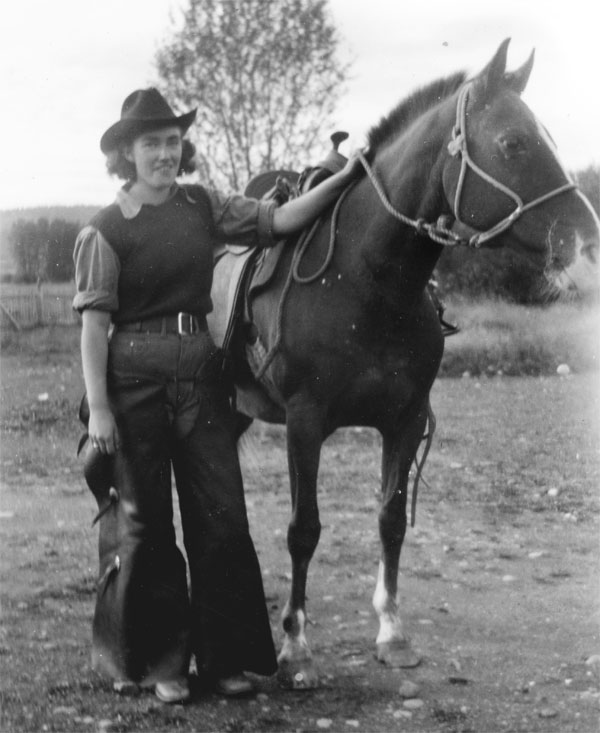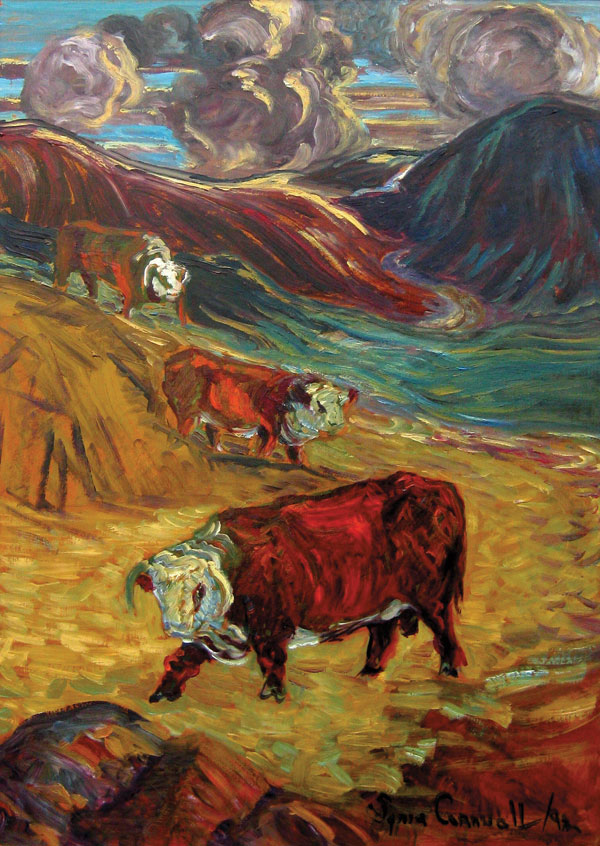
Cariboo artist Sonia Cornwall (1919 – 2006) is one of the few women inducted into the B.C. Cowboy Hall of Fame. Over the years, she herded cattle, drove tractors and bulldozers, mended fences, helped with haying, and did other agricultural jobs. Working the ranch was unusual for a female of her day, but Sonia had little choice.
When her father Charles Cowan died in 1939, his wife Vivien and two daughters (Sonia 19, Drusilla 10) were shocked to learn that Cowan’s debts amounted to approximately $93,000. The only way to pay this off was to continue working the family’s cattle operation on the Onward and the 150 Mile ranches near Williams Lake, B.C.
Sonia traded her dream of becoming a theatrical set designer for a life that included long hours herding 700 or so cattle. She complained she had to rake hay with “an old fashioned dump rake. The hay was so heavy that it would pull my right foot off the dump lever. I was always glad one had to rest the horses in a shady spot every so often as I found it very tiring.” Moreover, the hired hands did not treat her with any deference. On her first day of haying, Sonia was so exhausted that she rested somewhat prior to eating her share of the crew’s lunch. She never did that again because within a few minutes, the food was gone and the men were napping. While the ranch manager prohibited Sonia from helping with castrations, he did not mind ordering her to plant two hundred cabbages. With the earnings from her first hay season, Sonia treated herself to proper riding boots. The next year she bought herself a pair of chaps. A First Nations neighbour taught Sonia to trap, and she used the money from her fur sales to buy cigarettes.
In 1947, Sonia married Hugh Cornwall (another inductee into the B.C. Cowboy Hall of Fame). Three years later, he became the Cowan’s ranch manager. The Cornwalls had two daughters and, besides raising them, Sonia carried out various ranch duties including cooking for haying crews of up to twenty men. Moreover, Sonia often helped with various local festivities and, according to her mother, once cooked “two hundred pounds of beef stew” for a cattlemen’s dance.
In 1950, the 150 Mile Ranch sold, and the Onward in 1964. The Cornwalls retained 2,500 acres that they named Jones Lake Ranch.

Throughout the years, Sonia harboured her dreams of creating art. She did so whenever she could. At the celebrations following the annual three-day Williams Lake cattle sale, Vivien recalled that “tobrighten the dismal room (40′ x 60′) Sonia would paint murals of the Cariboo country on rough paper (white sheets about 4’x 8′) which lined the walls.” She also painted ranch scenes on wooden panels and some of those depictions are housed by the Museum of the Cariboo Chilcotin.
Through Vivien and Sonia’s contacts, a number of noted Canadian artists such as Molly Bobak, Joseph Plaskett, and Takeo Tanabe visited the Onward and Jones Lake ranches. Guests found gracious, fun-loving, and cosmopolitan hospitality; all the alcohol they could imbibe, hearty homemade meals, and intriguing conversations. In 1946, Group of Seven member A.Y. Jackson made his first trip to the Onward Ranch. Jackson encouraged Sonia and said that she captured an indescribable quality in her work. Numerous other artists and art historians agree with that appraisal. Art consultant Anthony Westbridge describes Sonia’s work as “rich, brash, ranchy” with an “ethereal quality.” One review of Sonia’s exhibition at the Kelowna Art Gallery (2000) described her work as a “testimony to the power of nature, the endurance of animals, and one suspects, the humans who care for them.” Eventually handicapped by age-related ailments, in 2000 Sonia started travelling on a modified golf cart while searching for paintable vistas.
Sonia’s work is of artistic, cultural, and historic value as she conveyed First Nations encampments, old or lost villages and churches, and rural practices that are now defunct or altered. Like Emily Carr, who devoted her life to depicting the West Coast, Sonia devoted hers to portraying rural landscapes and agrarian activities. Those images are as powerful as they are distinctive.
Sonia Cornwall died in 2006. She is buried in the family cemetery in the Williams Lake area.















